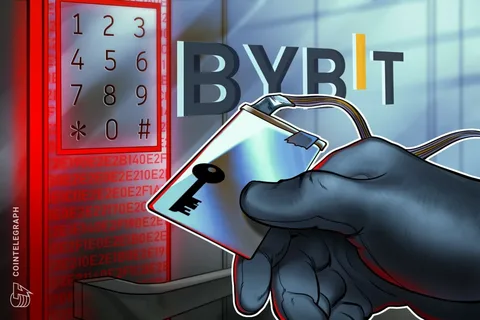Cryptocurrency exchanges have long been prime targets for cybercriminals, with billions stolen over the years. However, one of the most shocking incidents to date has recently unfolded—Bybit hacked in a staggering heist involving $1.46 billion in ETH and stETH. This unprecedented breach has sent shockwaves throughout the crypto community, raising concerns about security, regulation, and the future of centralized exchanges.
In this detailed analysis, we will break down how the ETH and stETH heist happened, its impact on the industry, and what users can do to protect themselves. Whether you’re an investor, trader, or simply interested in the world of blockchain security, this article will provide everything you need to know.

The Bybit Hack: How the $1.46 Billion ETH and stETH Heist Unfolded
The Bybit hacked incident is one of the largest crypto exchange breaches in history. Cybersecurity experts and blockchain analysts have been working tirelessly to trace the origins of the attack, but the exact details remain unclear. However, a few key factors have been identified in the unfolding of this Bybit Hacked.
1. The Initial Breach and Exploitation
Hackers often use a variety of techniques to gain access to crypto exchange systems, including phishing attacks, software vulnerabilities, and insider threats. In the case of Bybit hacked, early reports suggest that the attackers exploited a security loophole in the exchange’s hot wallet infrastructure, allowing them to withdraw massive amounts of ETH and stETH before alarms were triggered.
Once inside Bybit Hacked system, the attackers moved quickly. Blockchain forensics indicate that transactions involving stETH and ETH were dispersed across multiple wallets within minutes, making it difficult for Bybit’s security team to respond in time. Some security experts believe that the attack may have been in preparation for weeks or even months, with hackers meticulously studying the exchange’s security protocols before executing their plan.
2. Tracing the Stolen Funds: Where Did the ETH and stETH Go?
A major challenge in crypto-related cybercrimes is tracking stolen funds. While blockchain technology is transparent, hackers often employ sophisticated methods such as mixers, privacy coins, and DeFi protocols to obscure their transactions.
Blockchain investigators have identified several wallets receiving the stolen ETH and stETH, with some of the funds being laundered through decentralized exchanges (DEXs) and cross-chain bridges. This approach helps hackers convert stolen assets into less traceable forms of cryptocurrency, making recovery efforts difficult.
Despite these challenges, companies specializing in blockchain security—such as Chainalysis and PeckShield—are actively working with law enforcement agencies to trace and freeze stolen assets. The crypto community remains hopeful that at least some of the stolen funds can be recovered before they disappear entirely.
The Impact of the Bybit Hack on the Crypto Market
The Bybit hacked incident has had significant repercussions on the crypto industry, affecting not only the exchange’s users but also broader market trends and security concerns.
1. Investor Confidence Takes a Hit
Trust is one of the most crucial elements in the crypto space, and when a major exchange suffers a $1.46 billion ETH and stETH heist, confidence is inevitably shaken. Many users have started questioning the safety of storing assets on centralized exchanges (CEXs) and are exploring self-custody solutions such as hardware wallets.
2. Price Volatility in ETH and stETH
Following the news of the Bybit hacked incident, ETH and stETH experienced increased volatility. Panic-selling from investors fearing additional security breaches contributed to price fluctuations, while some traders attempted to capitalize on the short-term movements caused by the uncertainty.
Staked Ethereum (stETH) also saw a temporary depeg from ETH due to concerns about its involvement in the heist. However, market stability was largely restored once major players in the crypto space reassured users that the security breach was limited to Bybit and did not impact Ethereum’s overall network integrity.
3. Regulatory Scrutiny Intensifies
The massive scale of the ETH and stETH heist has drawn the attention of regulatory authorities worldwide. Governments and financial watchdogs are once again questioning the security practices of centralized exchanges and considering stricter compliance measures.
Regulatory agencies may introduce new security requirements, such as mandatory proof-of-reserves, stricter KYC (Know Your Customer) policies, and enhanced cybersecurity audits to prevent similar breaches in the future.
Lessons Learned: How to Protect Your Crypto Assets
The Bybit hacked incident serves as a stark reminder of the risks associated with centralized exchanges. Here are some key takeaways for crypto investors looking to safeguard their funds.
1. Use Hardware Wallets for Long-Term Storage
One of the best ways to secure ETH and stETH is to store them in a hardware wallet rather than leaving them on exchanges. Hardware wallets, such as Ledger or Trezor, offer offline (cold) storage, making them nearly immune to cyberattacks.
2. Enable Multi-Factor Authentication (MFA)
Even though Bybit had some security measures in place, users can take additional precautions by enabling multi-factor authentication (MFA). This adds an extra layer of security, making it harder for Bybit Hacked
3. Use Decentralized Finance (DeFi) Platforms with Caution
While DeFi platforms offer greater control over assets, they also come with their own risks, including smart contract vulnerabilities and scams. Always research a platform thoroughly before engaging in transactions, and use reputable services with audited security protocols.
4. Monitor Exchange Security Reports and Withdraw Early if Needed
Keeping track of an exchange’s security practices and financial health can provide early warning signs of potential risks. If an exchange shows signs of financial instability or has poor security track records, consider withdrawing funds to a safer location.
Conclusion: The Future of Bybit and Crypto Exchange Security
The Bybit hacked incident marks yet another major breach in the crypto world, emphasizing the need for stronger security measures and increased vigilance among investors. While Bybit has promised to enhance its security and compensate affected users, this event serves as a wake-up call for the entire industry.
Moving forward, we can expect more scrutiny on centralized exchanges, better security solutions, and possibly even a shift toward decentralized finance (DeFi) solutions as users seek greater control over their assets.
What are your thoughts on the Bybit hacked event? Do you think exchanges can ever be 100% secure, or should investors rely on self-custody solutions? Share your thoughts in the comments below!






